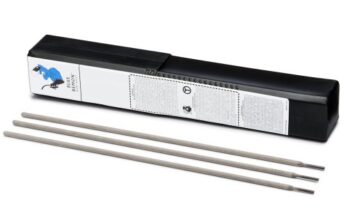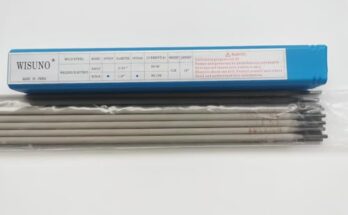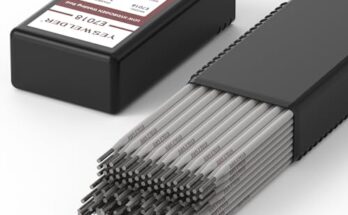Need a reliable welding rod for various projects? This guide dives deep into welding rod 7014, explaining its features, applications, and everything you need to know. Let’s get started!
7014 is a type of low-hydrogen, iron-powder electrode used in shielded metal arc welding (SMAW), often called stick welding. It’s known
for its versatility and ability to produce strong, high-quality welds in various positions. I’ve personally used 7014 for years on everything from repairing farm equipment to building custom metalwork, and its consistent performance has always impressed me. The “70” designation in its classification indicates a tensile strength of 70,000 psi (pounds per square inch), while the “14” specifies its characteristics: low-hydrogen, capable of welding all positions (including overhead), and featuring a rutile coating. This coating provides excellent arc stability and slag detachability, simplifying the welding process, especially for beginners.
Key Features and Benefits of 7014 Welding Rods
One of the things I appreciate most about 7014 is its forgiving nature. Its rutile coating makes it easy to strike an arc and maintain a consistent weld bead. The low-hydrogen content minimizes the risk of hydrogen cracking in the weld, crucial for structural applications. The coating also contributes to a smooth, easily detachable slag, reducing cleanup time significantly. This translates to increased efficiency, and fewer headaches on the job.
Beyond its ease of use, 7014 delivers exceptional weld quality. The iron powder in the electrode increases penetration and provides a good bead appearance. This characteristic is important for applications where aesthetics matter. The resulting weld is strong and durable, suitable for a wide range of applications.
For instance, I once had to repair a severely damaged section of a vintage motorcycle frame. The intricacy and the need for strength made this a challenging job. 7014’s ability to weld in all positions proved invaluable; it allowed me to reach every corner and crevice of the frame with ease. The weld held up perfectly under stress, which speaks to the reliability of the 7014 rod.
Comparing 7014 to Other Welding Rods
While 7014 is a fantastic all-around electrode, it’s not the perfect choice for every application. Let’s compare it to some other popular electrodes:
| Feature | 7014 | 6010 | 6011 |
|---|---|---|---|
| Position | All positions | All positions except overhead | All positions |
| Penetration | Moderate | Deep | Moderate to deep |
| Slag Removal | Easy | Moderate | Easy |
| Arc Stability | Excellent | Good | Excellent |
| Hydrogen Content | Low | Higher | Moderate |
As you can see, 6010 offers deeper penetration, but struggles with overhead welding. 6011 boasts excellent arc stability and penetrates well, but may require more care in slag removal. 7014 sits nicely in the middle, offering a balance between ease of use and performance. The choice ultimately depends on the specific needs of your project and your personal welding experience.
Applications of 7014 Welding Rods
Welding Various Metals with 7014
7014’s versatility shines in its compatibility with different metals. I’ve successfully used it on mild steel, which is its primary application. However, its adaptability extends to other ferrous materials, such as low-alloy steels. Keep in mind that the specific characteristics of the base metal, such as thickness and cleanliness, can influence welding parameters. Always ensure the surface is properly cleaned before welding to achieve optimal results. This might involve grinding, wire brushing, or chemical cleaning, depending on the level of contamination.
The rod’s excellent arc stability and ease of use make it a beginner-friendly option. This makes it well-suited for both small hobby projects and larger-scale industrial tasks. I recall using 7014 to weld several pieces of sheet metal together during a recent automotive repair job. The precise control afforded by the rod allowed me to create clean, strong welds without any significant spatter or undercut, demonstrating its versatility in thin gauge applications.
7014 in Different Welding Positions
One of the major selling points of 7014 is its all-position capability. Unlike some electrodes that struggle with overhead welding, 7014 handles all positions with remarkable consistency. This makes it ideal for projects with complex geometries or difficult-to-reach areas. I’ve used this feature extensively when welding pipe sections in tight spaces where access was limited. The precise bead control and ease of slag removal helped ensure strong, structurally sound welds.
The ability to weld in all positions translates to flexibility in various applications. For example, when fabricating a custom metal art piece that required welding in several different orientations, 7014 delivered excellent results. The consistent arc and bead control made creating the intricate designs smoother and faster than I anticipated.
7014 for Different Thicknesses of Metal
7014 is suitable for welding a range of metal thicknesses. Its versatility extends to both thin and thick materials. However, adjustments to amperage and welding technique are necessary depending on the thickness being welded. For thinner metals, I always use a lower amperage setting to prevent burn-through. Conversely, a higher amperage may be needed for thicker materials to ensure proper penetration. The key is experimentation and knowing your equipment to achieve good quality welds consistently.
For example, when welding thin sheet metal, a slightly shorter arc length and a gentle hand are essential to avoid melting holes through the work piece. On the other hand, thicker materials require a longer arc to generate enough heat for adequate penetration. I’ve found that practicing with scrap metal of various thicknesses beforehand helps build confidence and proficiency with the 7014.
Choosing the Right Welding Rod 7014
Rod Diameter and its Impact on Welding
The diameter of the 7014 welding rod significantly impacts the welding process and the type of project it’s suitable for. Thinner rods (e.g., 1/16 inch) are better suited for delicate work and thinner materials, requiring less amperage and offering more precise control. Thicker rods (e.g., 5/32 inch), on the other hand, are best for welding thicker sections of metal, and require a higher amperage to generate the heat necessary for deep penetration.
My experience has shown that choosing the right rod diameter is crucial for achieving the desired weld quality. I remember a project where I needed to weld thin sheet metal. Using a thicker rod would have resulted in burn-through and a messy weld. Selecting a 1/16 inch diameter rod allowed me to execute clean, precise welds. It’s critical to choose a rod diameter that is proportional to the thickness of the base material for best results.
Understanding the Electrode Coating
The rutile coating on a 7014 welding rod is not just a protective layer; it’s a crucial element that directly impacts weld quality and ease of use. It plays a key role in the arc’s stability, slag detachability, and the overall welding performance. A high-quality rutile coating ensures a smooth arc, making the process more manageable, especially for beginners. It also helps produce a smooth, easily removable slag, which is an efficiency booster.
I have noticed that some lower-quality 7014 electrodes exhibit inconsistent coatings which can lead to erratic arc stability, excessive spatter, and difficult slag removal. Investing in high-quality electrodes from reputable manufacturers is always a worthwhile investment; it ensures consistent performance and ultimately results in higher quality and more efficient welding.
Manufacturer and Quality Considerations
The quality of the welding rod significantly impacts the end result. Different manufacturers utilize varying production processes and materials, leading to differences in quality and performance. Reputable manufacturers like Lincoln Electric, Hobart, and Miller are known for producing high-quality electrodes that consistently deliver on their promises. Buying from trusted sources is crucial for achieving consistent results and preventing problems such as inconsistent arc stability or difficult slag removal.
In my experience, investing in a premium brand electrode pays for itself in the long run. High-quality 7014 rods consistently provide smooth, consistent arc stability, reducing the chance of mistakes and rework. The superior coating ensures easy slag removal and a cleaner weld, leading to a significant improvement in overall productivity and weld quality.
Safety Precautions While Using 7014 Welding Rods
Essential Safety Gear and Protective Measures
Welding, especially with SMAW, can be hazardous if proper safety measures aren’t taken. The arc produces intense ultraviolet (UV) and infrared (IR) radiation that can severely damage eyes and skin. Always wear a proper welding helmet with a shade appropriate for the amperage being used. I always recommend at least a shade 10 or higher for 7014 welding. Additionally, wearing protective clothing such as heavy-duty gloves, long-sleeved shirts, and sturdy pants is essential. Proper eye protection is paramount to prevent welder’s flash or eye damage. The risk of burns or electric shock also necessitates caution.
Beyond the personal protective equipment, proper ventilation is also crucial. The welding process generates fumes and gases that can be harmful if inhaled. Working in a well-ventilated area or using a respirator is vital, particularly when working with larger projects or in enclosed spaces. The fumes produced during welding can irritate the respiratory system and have long-term health consequences.
Proper Handling and Storage of 7014 Electrodes
Proper handling and storage of 7014 electrodes are essential for maintaining their quality and preventing performance issues. Store them in a dry place, away from moisture and extreme temperatures. Moisture contamination can significantly affect the welding performance and cause arc instability. I’ve learned from experience that storing the electrodes in a sealed container with a desiccant helps prevent moisture absorption. The packaging should also be kept dry and undamaged.
Before using the electrodes, always inspect them for damage. Any cracks or significant damage to the coating should disqualify them from use. Using a damaged electrode can lead to problems like inconsistent arc stability or a weak weld. Always ensure proper handling and avoid dropping or bending the rods, as this can compromise the coating and its integrity.
Understanding Electrical Hazards in Stick Welding
Stick welding involves working with high voltage, posing risks of electrical shock. Ensure all electrical connections are secure and properly insulated. Use appropriately rated cables and ensure that the welding machine is properly grounded. Avoid touching metal parts that could be carrying current. Regular inspection of the welding equipment is essential for safety, and maintaining it to appropriate standards will mitigate potential hazards. Improper grounding and worn-out cables are major causes of electrical shocks during welding.
Never attempt to weld when you’re fatigued or under the influence of alcohol or drugs. Maintaining focus and alertness are critical for safety. Before working with 7014, always ensure you understand the electrical system associated with your welding machine and that you know how to properly shut down the machine before carrying out any maintenance.
Troubleshooting Common Problems with 7014
Addressing Issues with Arc Stability
One common issue with 7014 is arc instability. This can manifest as a sputtering arc, sticking, or difficulty maintaining a consistent weld. Several factors can contribute to this problem. Ensure the electrode is properly cleaned, the amperage is appropriately adjusted, and the arc length is correct. A dirty electrode or incorrect amperage can affect the performance significantly. Also, ensure that the surfaces being welded are clean and free of rust, paint, or oil. These factors also affect arc stability and result in poor quality welds. Improper grounding is another factor that can influence the stability of the arc.
If arc instability persists, check the welding machine’s settings, cables, and connections for any issues. If the problem continues, it’s advisable to try a new electrode to rule out issues with the electrode itself. In most cases, adjusting the amperage to the recommended level or ensuring the workpiece is properly grounded will solve the arc instability problems.
Dealing with Difficult Slag Removal
Another common issue is difficulty removing the slag from the weld. The slag is typically easy to remove with a 7014 electrode, but if it’s sticking, it may indicate a problem with the electrode itself, the welding technique, or the amperage. A lower-quality electrode or too low of an amperage setting often makes it harder to remove the slag. Conversely, using too high an amperage setting can lead to excessive slag formation and poor bead formation.
Using the right amperage, proper welding technique, and ensuring adequate preheating can help improve slag removal. A chipping hammer can aid in removing stubborn slag, but excessive force can damage the weld. Ensuring proper electrode angle and maintaining a consistent arc length also help in achieving smooth, easily removable slag.
Preventing Weld Defects with 7014
Understanding the cause of weld defects is crucial for avoiding them. Common defects such as porosity, undercut, or lack of fusion often result from insufficient penetration, improper welding technique, or contamination. Proper amperage, arc length, and electrode angle are key to ensuring proper penetration and a strong weld. Always clean the metal surfaces before welding, removing any rust, scale, paint, or oil. Contamination leads to weak welds and other defects.
Addressing issues like arc instability, difficult slag removal, and weld defects is all about understanding the fundamentals. Proper technique, correct electrode selection, and paying close attention to details will result in cleaner, stronger welds.
Frequently Asked Questions
What is welding rod 7014 best for?
7014 is excellent for all-position welding of mild steel and low-alloy steels. Its versatility makes it ideal for various applications, from automotive repairs to structural work, and even artistic metal fabrication. It excels in situations where precise control and ease of use are paramount. Learn more about its various applications in different industries.
What amperage should I use with 7014?
The appropriate amperage depends on the diameter of the electrode and the thickness of the metal being welded. Consult the manufacturer’s specifications for the exact amperage range. Generally, you’ll need higher amperage for thicker materials and larger diameter electrodes. Experimenting with amperage on scrap metal before starting your project is highly recommended. Learn more about proper amperage settings for optimal welding results.
Can I use 7014 on rusty metal?
While 7014 can handle some surface rust, extensive rust or other contaminants will severely compromise the weld’s integrity. Always thoroughly clean the metal surfaces before welding to ensure a strong, reliable bond. This often involves using a wire brush or grinder to remove rust and scale. Learn more about surface preparation techniques for welding.
How do I strike an arc with 7014?
Strike an arc by touching the electrode to the metal, then quickly pulling it back to the correct arc length. The rutile coating makes this relatively easy. A consistent arc length is essential for maintaining a stable and smooth weld bead. Practice striking the arc on scrap material until you feel confident and consistent. Learn more about arc striking techniques for different welding scenarios.
What are the limitations of 7014?
While versatile, 7014 might not be ideal for every application. It doesn’t offer the same deep penetration as some other electrodes, like 6010. It’s also less suitable for extremely thick materials where higher penetration is critical. Consider the specific requirements of your project before choosing the electrode. Learn more about comparing welding rods for different applications.
How should I store 7014 welding rods?
Store 7014 electrodes in a dry place to prevent moisture absorption. High humidity can negatively affect the performance and cause problems during welding. Keeping them in a sealed container with a desiccant can further protect them. Always check the packaging for any signs of damage before use. Learn more about preserving the quality and performance of your welding supplies.
Is 7014 suitable for beginners?
Yes, 7014 is considered a beginner-friendly electrode due to its easy arc striking, smooth arc, and readily removable slag. However, always practice safety precautions and start with smaller projects to gain experience before tackling more challenging tasks. Remember to always follow the manufacturer’s instructions and safety guidelines. Learn more about getting started with stick welding.
Final Thoughts
Welding rod 7014 is a workhorse electrode that offers excellent versatility, ease of use, and high-quality welds. Understanding its characteristics, applications, and limitations empowers you to utilize it effectively for various projects. While this guide provides a comprehensive overview, continued practice and experience are essential for mastering 7014 welding. Remember, safety always comes first. Ensure you utilize proper safety gear and techniques to prevent injuries. Take your time, practice with scrap metal, and you’ll be creating strong, reliable welds in no time. So, what are you waiting for? Get out there and start welding!


